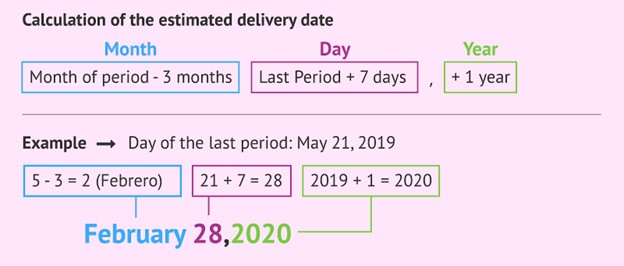A client's last menstrual period was April 11. Using Nägele's rule, her estimated date of birth (EDB) would be:
February 18
January 18
January 8
December 28
December 18
The Correct Answer is C
Choice A Reason: This is incorrect because it adds 10 months and 7 days to the last menstrual period, which is not Nägele's rule.
Choice B Reason: This is incorrect because it adds 9 months and 7 days to the last menstrual period, which is not Nägele's rule.
Choice C Reason: This is correct because it follows Nägele's rule, which is to subtract 3 months and add 7 days to the last menstrual period.
Choice D Reason: This is incorrect because it subtracts 4 months and adds 7 days to the last menstrual period, which is not Nägele's rule.
Choice E Reason: This is incorrect because it subtracts 4 months and adds 17 days to the last menstrual period, which is not Nägele's rule.

Nursing Test Bank
Naxlex Comprehensive Predictor Exams
Related Questions
Correct Answer is D
Explanation
Choice A Reason: This is incorrect because Ortolani's sign is a test for hip dysplasia in infants, not a sign of pregnancy. It involves moving the infant's legs to check for a clicking sound in the hip joint.
Choice B Reason: This is incorrect because Chadwick's sign is a bluish or purplish discoloration of the cervix, vagina, and vulva during pregnancy, not a softening of the lower uterine segment. It is caused by increased blood flow to the pelvic area.
Choice C Reason: This is incorrect because Goodell's sign is a softening of the cervix during pregnancy, not a softening of the lower uterine segment. It is caused by increased vascularity and edema of the cervical tissue.
Choice D Reason: This is correct because Hegar's sign is a softening of the lower uterine segment or isthmus during pregnancy. It can be felt by bimanual examination around six to twelve weeks of gestation.
Correct Answer is D
Explanation
Choice A Reason: This is incorrect because it is too early. Naegele's rule is a formula that estimates the date of birth by adding one year, subtracting three months, and adding seven days to the date of the last menstrual period. Applying this rule to April 11 gives February 18, not February 24.
Choice B Reason: This is incorrect because it is too early. Naegele's rule gives February 18, not January 18.
Choice C Reason: This is incorrect because it is too early. Naegele's rule gives February 18, not January 25.
Choice D Reason: This is correct because it follows Naegele's rule. Adding one year, subtracting three months, and adding seven days to April 11 gives February 18.
Whether you are a student looking to ace your exams or a practicing nurse seeking to enhance your expertise , our nursing education contents will empower you with the confidence and competence to make a difference in the lives of patients and become a respected leader in the healthcare field.
Visit Naxlex, invest in your future and unlock endless possibilities with our unparalleled nursing education contents today
Report Wrong Answer on the Current Question
Do you disagree with the answer? If yes, what is your expected answer? Explain.
Kindly be descriptive with the issue you are facing.
